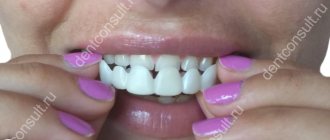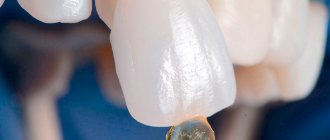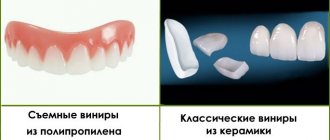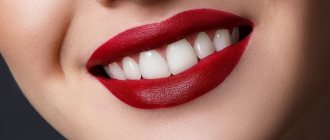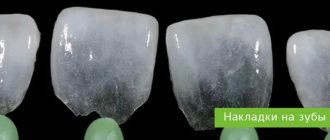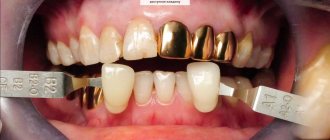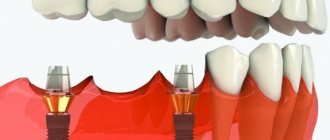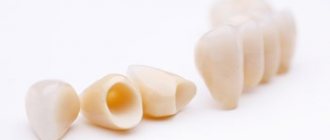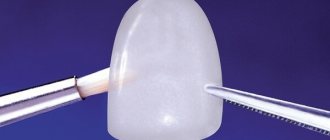Technology such as veneers has existed for decades. But many patients still have questions: how convenient, practical, and most importantly, how safe is it for dental health? After all, the enamel has to be ground down before the procedure, and the plates are installed once for many years. Is it possible that caries will develop under the veneers over the years? Today we destroy these myths.
Veneers are selected according to shade, size and thickness so that the smile looks natural and beautiful.
Contraindications and restrictions
Since we objectively consider veneers, with their advantages and disadvantages, we note that they have an important practical disadvantage - they are not suitable for everyone.
Doctors do not recommend installing these microprostheses in the following cases:
- There are no premolars (“sixes”), so there are difficulties with chewing function.
- The bite is seriously deformed.
- The incisor is significantly damaged, and therefore it is difficult (there is nothing) to attach the plate.
- The volume of the filling exceeds 50% - this also reduces the reliability of fixation.
- The patient is interested in martial arts, contact sports, or other activities that can cause jaw injuries.
- A person has bad habits that contribute to the appearance of caries or other diseases, for example, bruxism or a passion for cracking nuts.
In any of these situations, you can use some other restoration option. Moreover, such plates must be worn with caution so as not to damage them.
The benefits of veneers for teeth
Providing a beautiful smile and hiding minor defects, they have the following practical advantages:
- Durability - 5 years is their minimum service life, 7-10 is average (with careful biting of food, oral hygiene and compliance with other rules).
- Environmentally friendly, durable structures designed to minimize the risk of chipping.
- Hypoallergenic - in the manufacture of such pads, materials are used that not only do not cause irritation or other negative reactions, but are also biocompatible with all tissues of the body.
- Aesthetics – when considering the pros and cons of veneers for the front teeth, it is important to consider that they are completely invisible compared to other incisors; It’s not a problem to choose the shade, gloss and even the degree of transparency similar to natural enamel.
- Resistance to staining - the plates do not change their color after drinking tea, wine, coffee and other products, and do not turn yellow as a result of smoking or simply over time; If necessary, they can always be polished.
In addition, microprostheses are distinguished by gentle installation: before fixing them, there is no need to grind the incisor, it is enough to just remove a thin layer of enamel. Well, the edges of these overlays do not have to be hidden in the gums or other soft tissues of the oral cavity. This means no discomfort: with them, a person does not feel a foreign body at all and smiles as naturally as possible. There is also no need to get used to it.
Basic indications for installing plates
Veneers are used for dental problems. If the dental units are fragile, it is worth remembering that the plates will only aggravate the situation. Onlays effectively mask defects and allow you to restore the dentition without causing significant damage to the enamel.
Microprostheses are recommended for chips, cracks, stains on the enamel, uneven teeth, noticeable gaps between them, crowding, developmental defects, age-related changes, worn enamel, injuries, curvatures, wedge-shaped defects, demineralization of the enamel shell after wearing braces.
Only a dentist can tell the patient whether installing veneers will help get rid of existing defects. He will also select the appropriate material for the linings.
What are the disadvantages of veneers that need to be taken into account?
The main disadvantage is that they cannot be removed by yourself or even dismantled without damaging them. These are not braces. Well, the enamel needs to be prepared - yes, in a thin layer, only 0.5-0.7 mm, but even such an impact can bring negative consequences. Protection against pathogens, aggressive environments, mechanical and chemical factors deteriorates.
As a result, you cannot simply remove the plates - after this you need to either attach new ones or use some other method of restoring the beauty of your smile.
Existing pathologies should also be taken into account. In severe cases, microprostheses can provoke a change in diction. Another disadvantage of veneers lies in the fact that the teeth protruding from under them will still be stained and darken, which means that over time they will become different in color, at least on the inside. To prevent this aesthetic problem, you need to change your menu and stop smoking. Although giving up bad habits is, in principle, a sound idea, even if everything is fine with a smile.
These overlays must be fixed by a specialist, because in case of non-compliance with the technology or errors, the following unpleasant consequences are possible:
- Loose fit and, as a result, darkening of the plate.
- Protruding edges that can cause injury to the soft tissues of the oral cavity.
- A manifestation of hypersensitivity, indicating either poor enamel cleaning or the development of caries.
In addition, you can break off a piece of such a microprosthesis if you thoughtlessly bite into too hard food.
What it is?
A veneer is an overlay with a maximum thickness of 0.5 mm, made of composite material or porcelain. The tooth hidden behind it looks perfect because it masks minor enamel defects.
Overlays first appeared in the 30s of the last century in America. They were invented by C. Pincus. In this way, the dentist helped Hollywood stars achieve the perfect smile. The tooth was covered with an adhesive compound, which attached the veneer for up to 2-3 days. At that time, no one thought about whether it would cause harm, since no preliminary grinding was required. Modern records are strikingly different from the first ones, but still allow you to achieve the desired aesthetic effect in a short time.
Benefits and harms
It is important to understand that the pros and cons of veneers directly affect the quality of your bite. Thus, without much effort, you can visually correct minor imperfections and ensure a whiter and brighter smile. And this is without grinding down the incisor, only with the removal of a thin layer of enamel. If all the rules are followed, the plate will need to be replaced only after 10-20 years - the positive effect is obvious.
On the other hand, abandoning them after the first fixation is already problematic. You have to wear them for the rest of your life, periodically lightening them or putting on new ones. Why? Because 0.5-0.7 of the natural protective coating has already been removed. And the same premolars under microprostheses may ache, because after dental treatment they will become more sensitive and will react more sharply to hot and cold food.
So you should carefully weigh the pros and cons before deciding to have your smile corrected.
Cost and service life
Veneering, as an artistic restoration procedure, is always an individual work, painstaking and precise, requiring time and skill, designed for a number of sessions, which affects costs.
Also, prices directly depend on factors such as:
- material and type of records;
- fastening technology;
- number of nozzles;
- associated problems and pathologies.
The average service life is from 5 years (for composite) to 7-8 (for ceramic) or even up to 20 (for zirconium). True, these are not guaranteed figures: the time of comfortable wearing highly depends on attentiveness and accuracy. Some people manage to chip together microprostheses within a week, having decided to chew a pistachio or a “Grilyazh” candy, while others use them happily ever after, following all the rules prescribed by the dentist.
The range in cost allows you to make a choice. You can settle on budget options made from filling materials, get used to them, and then change to better ones. Well, or immediately spend money on a structure made of zirconium and ceramics for the long term. It's up to you to decide, but remember that each new installation means grinding down the enamel and paying for the dentist's labor.
Preparation stages
We carry out diagnostics and dental hygiene
Hygiene and CT scanning are extremely important, without them it is impossible to imagine high-quality installation of veneers today.
Computed tomography
We do this in order to look at all the teeth:
- if we have deep caries,
- where it is necessary to depulpate something,
- where there is inflammation,
- Are all the channels sealed correctly?
- how close is caries to the nerve,
- as a condition of the maxillary sinuses,
We also do a CT scan of the head in order to model everything in 3D.
Dental hygiene
is needed in order to work not with plaque, but with clean teeth.
Hygiene is also done in order to correctly determine the color. Because, for example, if we chose a color before professional hygiene, and then the patient brushes his teeth and it turns out that the color that we previously chose for veneers will stand out from the general range. After all, patients do not always place 20 veneers at once; we can talk about single dental restorations.
We remove damage to the enamel and dental tissues
I carried out the grinding for the mockup using special marking burs, so we cut off exactly as much as was needed to make a beautiful male smile
:
The grinding of some teeth affected by caries looks quite serious in the photo:
In all the examples in the photo below you can see a strong lesion
hard tissues of teeth.
In simple words, part of the teeth: the front incisors, premolars - rotted, that is, the caries was on the coronal part (crowns) of the teeth and was very deep. You can also see defects formed on the crowns, in those places where caries has severely affected the tooth. Pay attention to caries of the anterior incisors
:
This is what caries looks like on a canine
:
A rather positive factor was that the roots of the teeth remained intact. And if the tooth root is intact, it can be completely restored without removal or implantation.
Getting ready to change the shape of your teeth
We also had to play a little with the shape of the teeth in order to close all the gaps
when there are so many cracks and to do everything without cracks - it must be simply amazing professionalism.
We had to “play” not so much with the height, since our height hasn’t changed much, but rather with the width of the teeth
. Due to damage to the tooth enamel, carious teeth are literally rotten through and through. Each tooth had two caries on each side, and it also spread to the gingival areas.
In fact, the turning turned out very good and beautiful, clean. Absolutely free of dental caries. After installing veneers, Vitaly will not have caries for many years. This grinding allowed us to prepare the teeth and create a completely straight smile.
3D visualization
Why have I been using 3D visualization in my work for a long time? Because 3D visualization is the only way to show very clearly (both to me, to the patient, and to the technician) all the guidelines for the placement of teeth and the future smile.
Virtual 3D setup
- this is, first of all, absolute clarity for the patient, confirmation of the correctness of his decision about a beautiful smile:
A model was created on the computer - a virtual smile design. Then they 3D printed models of his future temporary teeth. That is, first we create two models on our computer - the first thing we do is wax up to make temporary veneers. The second step is to create a second veneer design on the prepared teeth. As a rule, both designs are the same, although it is believed that the second 3D veneer design is a more advanced 3D wax up
.

